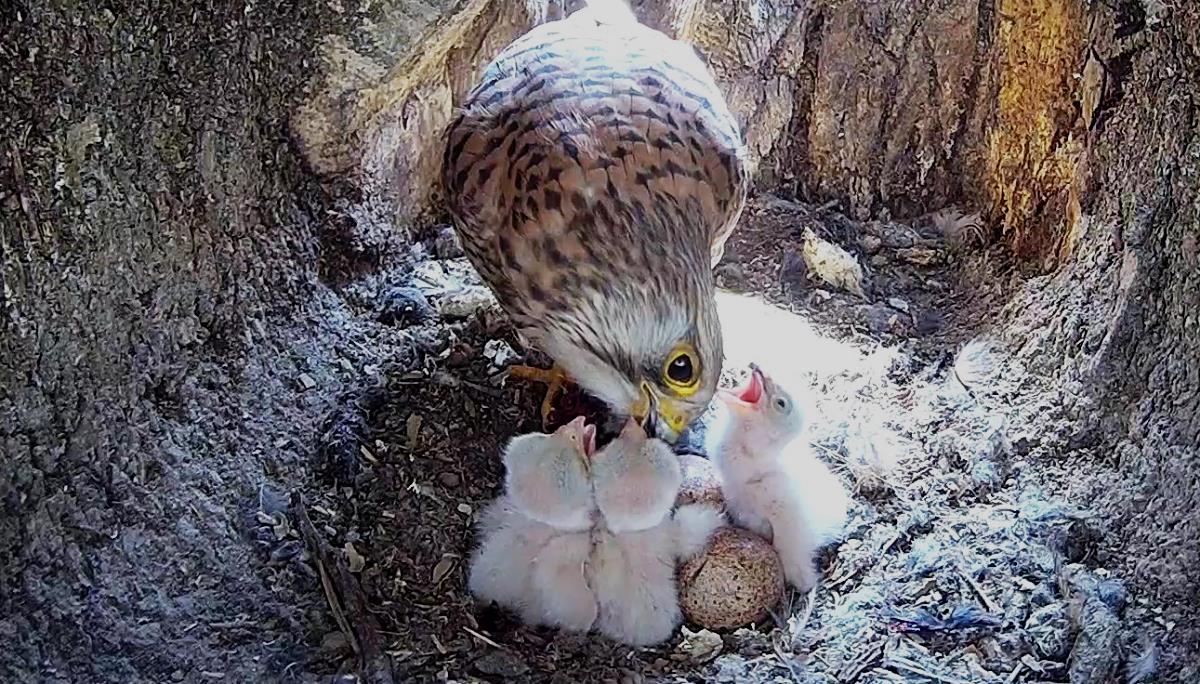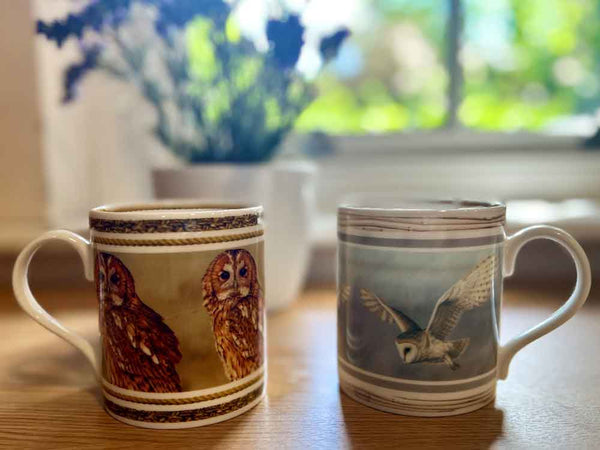All six kestrel chicks here at Fotherdale Farm in Yorkshire have hatched, in spite of brutal raids on their nests. Read on to find out more about the fascinating process of hatching and learn what a kestrel chick's egg tooth is. 
In spite of a series of raids on their nest, all six kestrel chicks have now hatched safely and are tucking into their first meals in my Sycamore Stump nest box. It's been such a joy to watch them chip out of their eggs, all feather wet and wobbly and turn into gorgeous balls of fluff within hours. Read on to learn more about kestrel chick hatching and find out why the safe hatching of this brood is such a welcome relief.
Despite raids on kestrel nest
This nest site is hotly contested and the parent birds have had to fight off a series of brutal raids from other birds to protect their clutch. During the latest, vicious battle, Mrs Kes was left bleeding and exhausted by an invading jackdaw and the eggs were scattered. She seemed so distressed she did not gather the eggs back under her and instead left the nest. I knew the chicks inside would not survive unless she continued to incubate and so I went in and re formed the nest scrape and brought the eggs back into a clutch. Thankfully, when she returned she settled back down to brood. But by now three of the eggs were very cold. Click here to read about the story.
Kestrel chicks hatch in quick succession
After this ordeal it was a relief to see the first and second chick hatch safely on Monday, May 10th at 10:58. It was followed three hours later by the second at 14:11. The next two hatched 15 hours later on the following day, Thursday, May 13th, at 0:15 and the fourth hatched 10 hours later at 15:50. Chick number five hatched the following day, at 16:32, again after a 15 hour time span and chick six at 11:57. Kestrels do not sit down to incubate their eggs until the third is laid so this explains how the chicks then hatch within such a short time span.
Barn owl attacks kestrel nest
But on the first night of hatching there was another attack on the nest, this time from a barn owl. Thankfully Mrs Kes was quick to react and managed to evict the owl,. However, barely 20 minutes later the owl was back and the kestrel had to get up the strength to fight again. She is a formidable falcon and quickly grabbed the barn owl by its feet, instantly disabling the owl and twisting it up and out of the nest. Worryingly the two day-old chicks, both very small, and the remaining eggs were flung around during the scuffle. But Mrs Kes quickly gathered them underneath her and sat back down to brood.
Kestrel chicks unharmed
My cameras offer a direct view into the secret world of these falcons and it has been amazing to see the chicks tucking in to their first meal within hours of hatching. When the chicks emerge their feathers are wet from the membrane inside the eggs and they are still pink. It is interesting to see how the adult kestrels clear away the egg shells once they've hatched. Mostly this is the female who eats the shell to regain nutrients lost during egg laying. Within hours the chick's feathers dry and they become tiny balls of fluff. They are so small the female has to be careful not to step on them. It was amazing to see Mrs Kes clench up her talons after her first chicks hatched so that she didn't hurt them when she stepped over to brood.
Kestrel egg tooth
An egg tooth is a 'horn' on the end of a chicks beak which they use to chip out of the egg. As the chick grows and its beak develops and hardens this tooth drops off. Almost as soon as they hatch, the chicks' tiny beaks gape and it's time to feed them, however nutrients from the egg yolk, which the chicks form around when they develop inside the egg, continue to sustain them during the first few days.
Kestrel chicks feeds

During these very early days the chicks are fed in order of their hatching, but very quickly feeding times become much more orderly and Mrs Kes lines them up to make sure they each get the same amount. Although the male brings in food for his growing brood, he doesn't actually feed them until they are much older. It is the female that tears up the food into tiny morsels and feeds each chick in turn. So it was hilarious when on the second day the male, Mr Kes, brought in a wood mouse whole. Mrs Kes wasn't in so he looked about helplessly and then simply dumped the food on top of the tiny chicks as if to say, 'Well there you go, there's your dinner!' What a typical male! Thankfully Mrs Kes arrived soon after and took over, gently feeding each chick in turn.
Watch the kestrel family live
You can tune in to watch the action from inside this kestrel nest on my YouTube channel and to learn more about the hatching process watch my live broadcast and Q&A session below where you can also see the footage from the behaviour mentioned above. Click here to watch the nest on my livestream.














